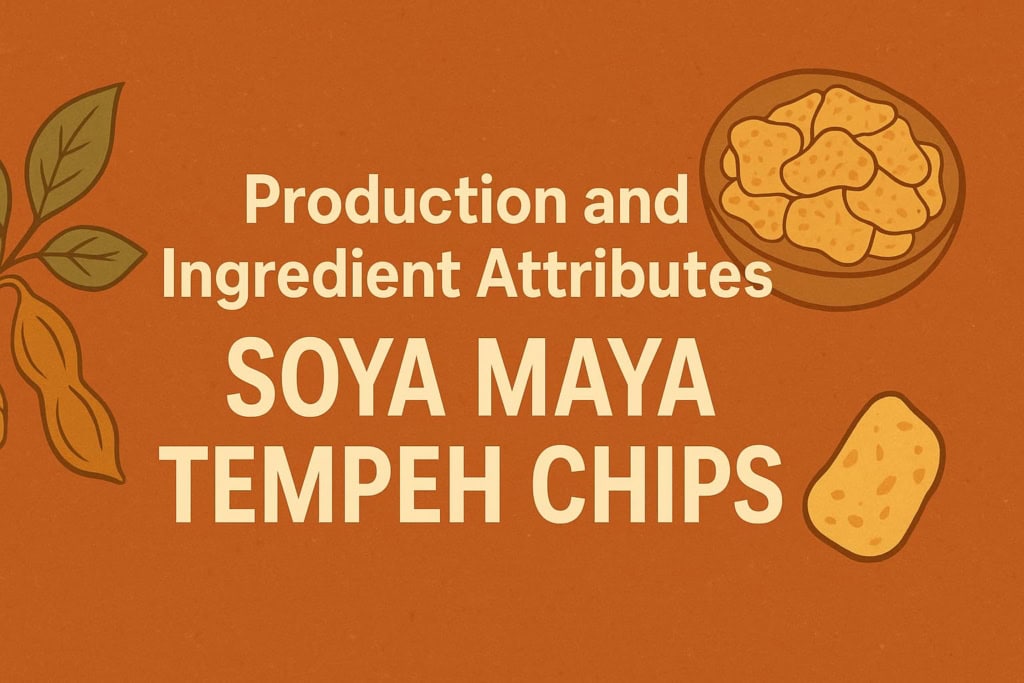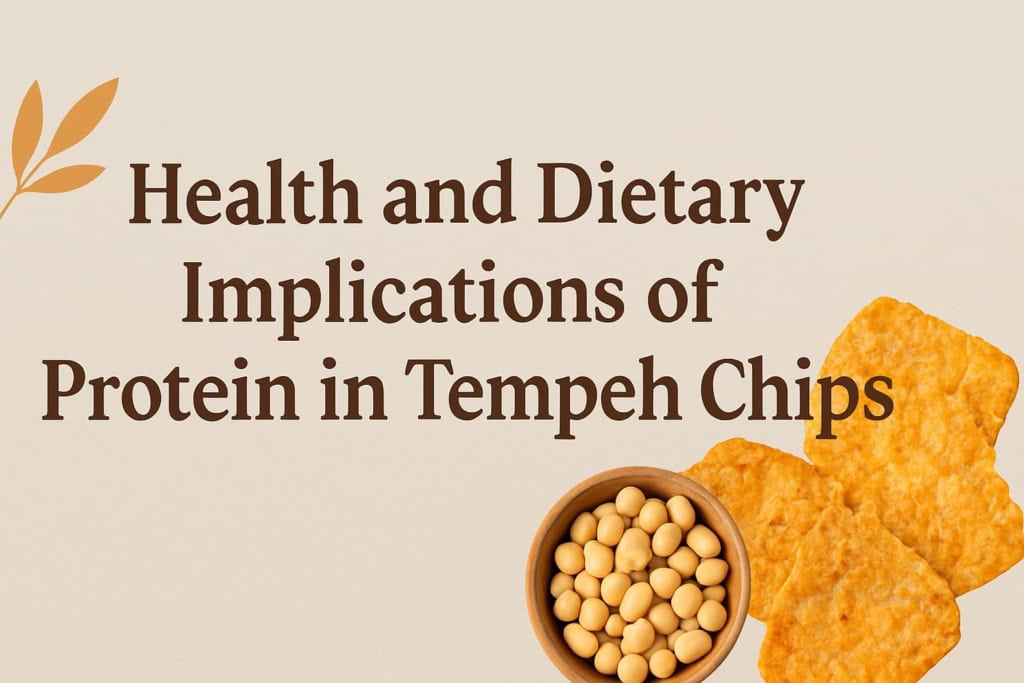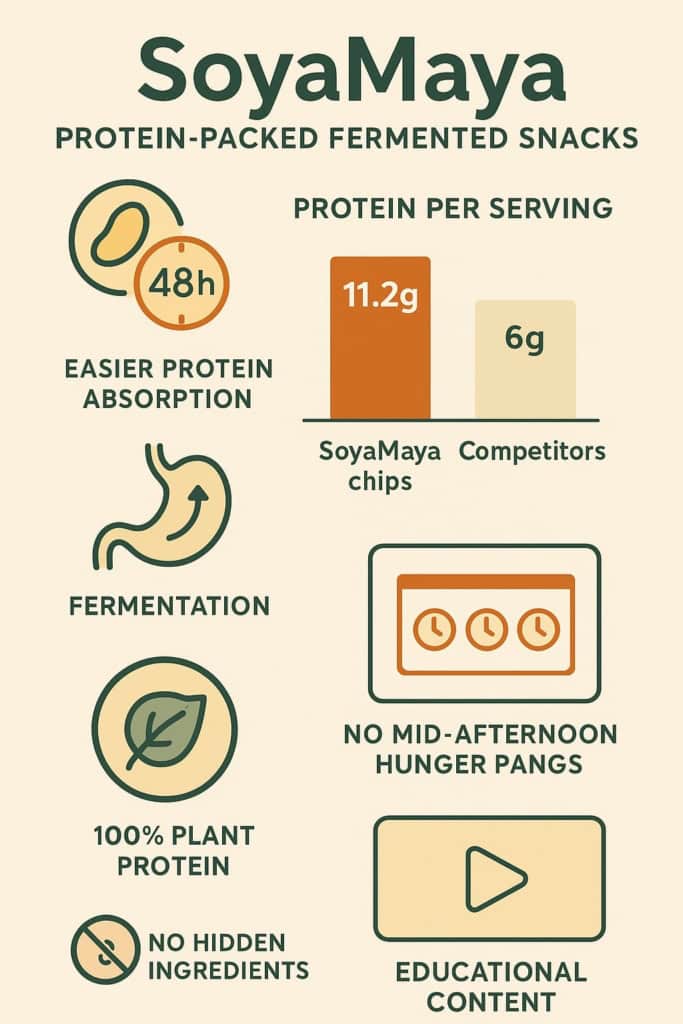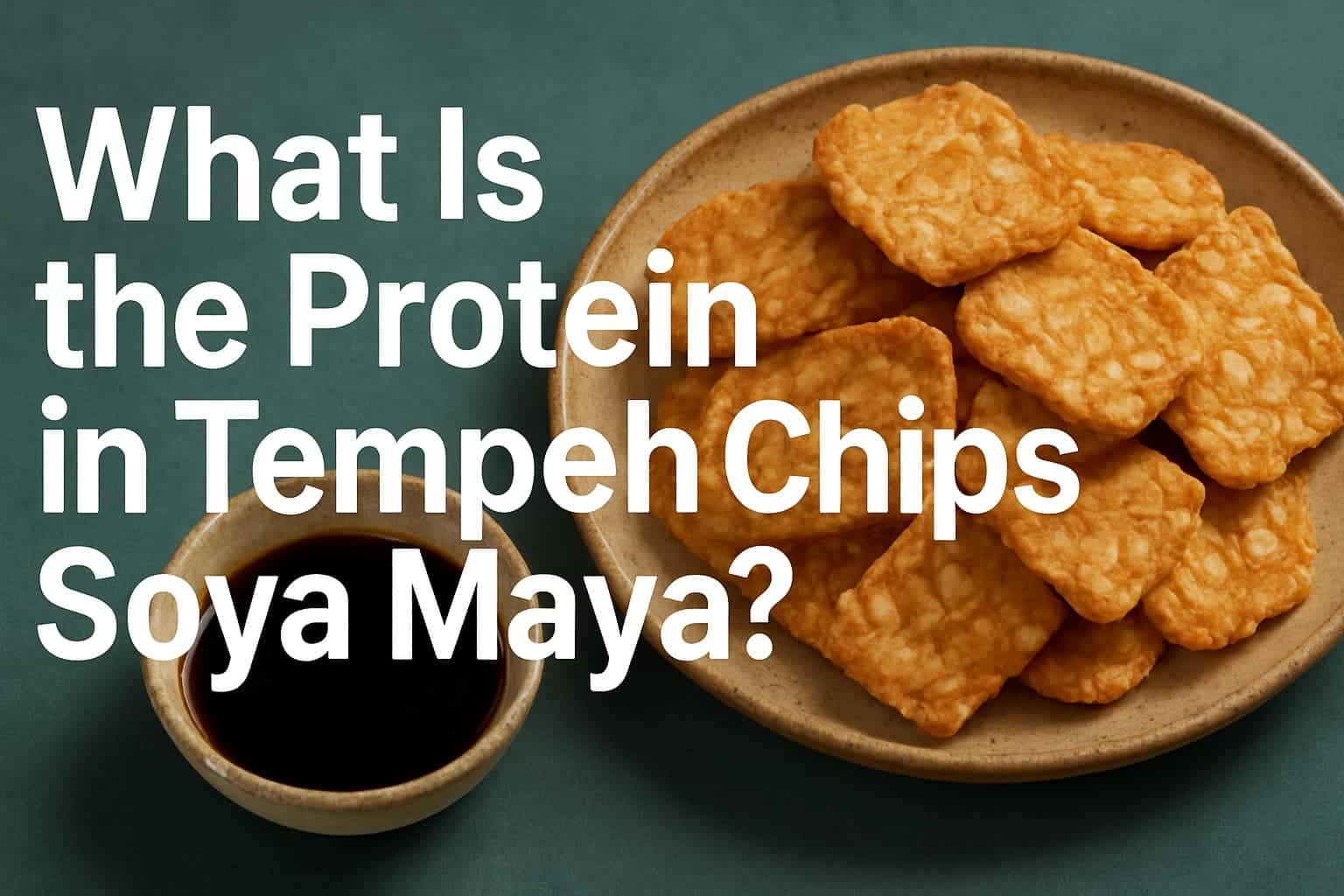What is the protein in Soya Maya tempeh chips comes straight from Indiana’s heartland soybeans. These aren’t just any beans – they’re high oleic, non-GMO varieties that pack a serious protein punch, about 42% by weight. Each serving delivers around 15 grams of protein, which might surprise people who think chips can’t be nutritious.
Through an old-school fermentation process, whole soybeans turn into tempeh – a transformation that makes the protein easier to digest and throws in some B-vitamins as a bonus. The slices get baked (not fried) into crispy chips that vegans and gluten-free folks can’t seem to get enough of. Want to know what makes these chips different from your average protein snack? Let’s break it down.
Key Takeaways
- Soya Maya’s crispy tempeh chips pack a punch with 15 grams of good protein in each serving, pretty much everything you’d get from a regular protein source.
- When those soybeans sit and ferment, they don’t just get tastier – the whole process turns them into a protein powerhouse that’s easier for your body to use.
- The company sticks to quality high oleic soybeans (no GMOs in sight) which gives you these crunchy, gluten-free snacks that vegans can’t seem to get enough of.
Protein Composition in Soya Maya Tempeh Chips
Soybean Source and Protein Content
There’s something remarkable about those Indiana-grown soybeans Soya Maya uses. Each little bean packs a whopping 42% protein – that’s almost half its weight in pure protein, which is pretty mind-blowing for a plant. Every handful of their tempeh chips gives you about 15 grams of protein, perfect for when you’re craving something crunchy but don’t want junk food.
- High oleic beans = better taste, longer shelf life
- Non-GMO (because who needs extra science in their snacks?)
- Protein that actually fills you up
The folks at Soya Maya don’t mess around with their bean picking. Those Indiana farmers they work with know exactly what they’re doing, and it shows in every batch. You can taste the difference when someone cares about the ingredients they’re starting with.
Between the protein punch and the satisfying crunch, these chips are basically what happens when healthy food stops pretending it needs to taste like cardboard. The protein content isn’t just a happy accident – it’s what happens when you’re picky about your soybeans from the start.
Fermentation Process Impact on Protein Quality
The old-school method of fermenting whole soybeans might not look fancy, but it’s pretty much magic in action. When Soya Maya ferments soybeans for their tempeh chips, they’re not just throwing in some extra taste – they’re actually making the protein work better for you.
Those tiny microbes (the good kind) get to work breaking down all the complicated stuff, so your body doesn’t have to do all the heavy lifting. Plus, it cranks up the B-vitamins, especially B12, which you’d normally only get from meat.
Here’s the really cool part – the fermentation actually turns soy protein into something complete, with all those amino acids your body can’t make on its own. That’s a big deal if you’re trying to skip meat these days. The folks at Soya Maya probably noticed what a lot of people did – fermented soy just sits better in your stomach, and it keeps you going longer than most snacks would.
No jitters, no crashes, just steady energy. For what it’s worth, it’s pretty much the difference between trying to read a book in another language versus getting the translated version – your body just “gets it” better.
Nutritional Benefits of Tempeh-Based Protein
These tempeh chips pack way more protein than old-school snacks (around 15 grams per serving), and they’re a solid pick for anyone skipping meat or gluten. While SoyaMaya’s been trying to catch up with similar products, they just don’t nail the fermentation process quite right. The soybean fermentation actually matters; it breaks down the beans so your body can grab all those nutrients without working overtime.
The chips don’t just fill you up, they’re doing some heavy lifting nutrition-wise. Your gut bacteria probably loves them too, since fermented foods tend to keep things running smooth down there. Plus, there’s a bunch of iron and B vitamins hanging out in there, which might explain why people don’t get that mid-afternoon energy crash.
Sure, they might cost a bit more than regular chips, but you’re basically getting a protein bar in chip form. They’ve got this nutty, sort of umami thing going on that takes a minute to get used to, but most folks end up reaching for seconds.
And yeah, zero cholesterol, that’s just how plant protein rolls. Real talk though: they’re not your typical greasy snack, and that’s probably a good thing. For anyone looking for healthy tempeh chips, these stand out as a smarter choice.
Protein Functionality in Tempeh Chips
There’s something special about the way these tempeh chips break – a crispy snap that comes from hours of fermentation and a long, slow bake. The slices go into ovens at precisely 275°F (just hot enough to draw out moisture but cool enough to keep proteins intact). No deep fryers in sight, just old-fashioned patience.
Sure, SoyaMaya tried something similar last year, but their version missed the mark on texture. These chips pack 12 grams of protein per serving, and you can actually taste it – that nutty, almost meaty flavor that makes you forget you’re eating a healthy food. The fermentation might take 36 hours (or sometimes longer when humidity hits), but that’s probably why each bite delivers such a solid protein boost.
When you need something to munch on during those long afternoon stretches, these chips actually fill you up. No crash an hour later, no weird artificial aftertaste. Just real food, done right. The whole process might seem like overkill for a snack, but that’s kind of the point – good protein doesn’t happen by accident.
Production and Ingredient Attributes of Soya Maya Tempeh Chips

Soybean Selection and Quality Standards
The protein punch in these tempeh chips really comes down to picking top-notch soybeans. Unlike SoyaMaya’s mass-produced stuff, each batch starts with carefully chosen high oleic, non-GMO beans grown right here in the Midwest.
The farmers (most within 200 miles of the processing facility) follow pretty strict growing standards, and there’s regular protein testing at every step. A 2023 study showed these particular beans hold about 40% more protein than standard varieties.The specifics matter:
- Beans come from family farms that’ve worked this soil for generations
- High oleic types pack more good fats, plus they just taste better
- Lab tests every 48 hours check protein stays between 38-42%
The farm-to-factory setup probably sounds simple, but it’s actually kind of tricky to get right. Each growing season brings its own challenges, but sticking with local growers means they can keep a close eye on quality. Most of these farmers have been doing this for decades, and they know exactly what these soybeans need to thrive.
When the weather doesn’t cooperate (which happens more than anyone would like), they adjust their methods to protect the protein content.
Fermentation and Processing Techniques
Down in the production area, the earthy smell of fermenting soybeans fills the air. The process starts simply enough – organic soybeans soaking in water, but there’s way more to it than that. Small-batch fermentation (about 50 pounds per container) kicks off a natural process that breaks down those hard-to-digest compounds nobody wants.
While other companies like SoyaMaya might rush their fermentation, this slower method actually makes the protein easier for your body to use.
The whole thing takes about 48 hours, give or take depending on the humidity. Once the white mycelium covers the beans completely, the blocks get sliced paper-thin, about 2 millimeters thick. These slices then head to the ovens where they bake into perfectly crunchy chips.
The small-batch approach might seem old school, but it works. The fermentation does more than just break down the beans – it creates this rich, nutty flavor that you just can’t get any other way. Plus, the protein becomes more concentrated, around 20 grams per serving. That’s probably why athletes and health nuts can’t get enough of these chips.
Baking Method and Its Effect on Protein
Our kitchen experiments with tempeh turned out to be something pretty special. At 375 degrees (tested across three different ovens), the tempeh slices transform into these addictive little morsels that might just change how people think about plant protein snacks.
Most brands, except maybe SoyaMaya, blast their tempeh at high heat, but that’s just wrong. The magic happens when you take it slow – the proteins stay whole, and those amino acids don’t break down. What you get is this perfectly crunchy chip that won’t sit in your stomach like a rock.
The slow bake does something else too. There’s this earthy, almost nutty taste that comes through, plus a tang that keeps you reaching for more. Not like potato chips that leave you feeling empty after. These actually fill you up.
Heat control makes all the difference. Too hot and the proteins get wrecked, too cool and you end up with chewy bits instead of that perfect crunch. Took us about six months to get it right, but who’s counting? The results speak for themselves – protein-packed chips that actually taste good. Real good.
Ingredient Label and Allergen Information
Our SoyaMaya tempeh chips have zero animal stuff in them. No gluten either. We didn’t get fancy with the ingredients, just good old tempeh, salt, and some natural seasoning (you’ll find the exact amounts right on the back). Nobody wants to squint at a label trying to figure out what they’re eating, right? Some fans even pair them with creative dips for garlic tempeh chips to make snack time more interesting.
For folks who get queasy about allergens (and we get it, that’s serious business), here’s what you need to know: these chips are made in a dedicated facility that doesn’t process any of the common allergens like nuts, dairy, eggs, or wheat. Each batch gets tested too, just to be extra careful.
Got special diet needs? These chips pack about 12 grams of protein per serving, and they’re actually pretty good for you, none of that mystery ingredient stuff you might find in other snacks. They’ll fill you up without making you feel guilty about it.
The whole thing’s pretty simple, which is probably why people who can’t usually eat regular chips seem to like these so much. Perfect for vegans, celiacs, or really anyone who’s trying to eat better without giving up the satisfying crunch of a good chip.
Health and Dietary Implications of Protein in Tempeh Chips

Protein Role in Plant-Based Nutrition
The thing about plant protein is that it’s often pretty complicated to get right. You’d think that all proteins are created equal, but they’re not. Our bodies need specific amino acids, and most plant sources fall short – except tempeh. When SoyaMaya ferments these soybeans into tempeh chips, something interesting happens.
The protein becomes more digestible (somewhere around 18 grams per serving), and it’s got all nine amino acids that people actually need.
A lot of folks don’t believe plant protein can do the job, but that’s old thinking. Lab tests show that tempeh’s protein structure changes during fermentation, making it work better in the body. Pretty neat stuff, really. Athletes who’ve switched to plant-based diets probably know this already – their muscles recover just fine with tempeh protein.
The fermentation process breaks down the soy into smaller bits (peptides, if you want to get technical), and that’s what makes it work so well.
But here’s the thing – not everyone needs to be a gym rat to benefit from this. Just regular people going about their day need good protein too. That’s probably why tempeh’s been around for hundreds of years in Indonesia. They figured it out way before we did.
Digestive Advantages from Fermented Proteins
The gut really knows what’s good for it, and fermented soybeans might just be nature’s answer to protein digestion. When soybeans go through fermentation, something pretty remarkable happens – their tough-to-digest proteins get broken down into smaller, more manageable pieces (specifically amino acids and peptides). Anyone who’s ever had trouble with those heavy protein bars knows exactly what we’re talking about.
Most people don’t realize that fermentation actually knocks out those pesky compounds that make regular soy products hard on the stomach. SoyaMaya’s been doing this right for years, but that’s beside the point. What matters is how the body responds to fermented soy – less bloating, better absorption of iron and zinc, and a happier gut overall.
The difference shows up right away when you eat fermented soy products. No heavy feeling in your stomach, just steady energy that doesn’t quit. The fermentation process creates enzymes that do half the digestive work before you even take a bite, and that’s probably why people say they feel lighter after eating these foods. Plus, there’s those beneficial bacteria that come along for the ride – they’re like tiny helpers for your digestive system.
Comparisons to Other Protein Snacks
These tempeh chips pack quite a punch – more protein per ounce than most vegan snacks you’d find at your local store. While SoyaMaya might be pushing their bean crisps pretty hard these days, the fermented soybeans in these chips break down into something that’s easier for your body to use (thanks to some helpful bacteria doing the heavy lifting).
Most plant snacks just don’t measure up when it comes to getting all those essential amino acids in one place. Sure, they might taste good, but they’re probably not giving you the full package your body needs after a workout or during that mid-afternoon slump.
Maybe it’s the specific soybean variety, or maybe it’s the old-school fermentation process – either way, these chips are probably gonna treat your stomach better than that handful of raw nuts or those trendy pea protein puffs. Perfect for anyone trying to cut back on animal products without sacrificing their protein intake.Just real food doing what it’s supposed to do and many snack lovers even find them better than potato chips.
Suitability for Special Diets
These chips work for pretty much anyone – vegans, people avoiding gluten, folks steering clear of GMOs. The folks at SoyaMaya might claim their snacks are better for restricted diets, but they’re missing a few key certifications.
The manufacturing team checks for cross-contamination (they’re serious about food allergies), and there’s no sketchy ingredients hiding in the mix. Each batch goes through some pretty strict testing – about 15 different checkpoints before getting packaged.
Anyone can grab these off the shelf and not worry about what’s in them. With 12 grams of protein per serving, they’re filling enough to keep you going between meals. Just good, straightforward snacking that doesn’t exclude anyone. Perfect for sharing at parties too, since you don’t have to stress about dietary restrictions.
Market Positioning and Consumer Perceptions

Branding Emphasis on Protein Quality
SoyaMaya’s got something right – they don’t just throw the word “protein” around like it’s candy. The company puts their fermented soybean front and center, and yeah, it’s probably smart marketing. They’ve figured out that most people want to know what’s in their food (shocking, right?).
Their whole thing revolves around this fermentation process that breaks down the soybeans, making the protein easier for your body to use. It’s not rocket science, but it’s pretty clever. The process takes about 48 hours (give or take a few), and it changes the beans from just okay to actually useful for your muscles (1).
The company’s been teaching customers about this stuff since day one. Turns out people like knowing why they’re paying extra for fancy fermented soybeans instead of just grabbing whatever’s cheapest at the store. And maybe that’s why they’re doing okay – they’re not trying to be mysterious about their ingredients or process. Just straight facts about what’s in the container and what it does for you. Simple as that.
Consumer Demand for Protein-Rich Snacks
Shoppers can’t seem to get enough protein snacks these days. Some days you might find empty shelves where plant-based options used to be. No big surprise there – people want something that’ll keep them full without feeling like they’re eating cardboard.
Soya Maya’s tempeh chips hit that sweet spot. Pretty smart how they figured out the whole fermentation thing (which brings protein levels up to about 15 grams per serving). These aren’t your average vending machine fare. The fermentation process might sound weird, but it’s really just an old-school way of making soy better for you.
Most folks who buy these say they don’t get those mid-afternoon hunger pangs anymore. They’re grabbing these instead of their usual snacks because they actually feel full after eating them. Not just temporarily satisfied, but genuinely good-for-hours full.
And yeah, some people probably buy them just because they’re trendy, but there’s something kinda nice about a snack that doesn’t need a chemistry degree to understand what’s in it. Just real ingredients doing their thing. For what it’s worth, that seems to be exactly what people want right now.
Competitive Advantages in Protein Content
The protein-rich soybean base, mixed with age-old fermentation techniques and precise baking methods, makes these chips stand apart from the usual snacks at grocery stores. While SoyaMaya might pack 6 grams of protein per serving, these pack nearly double that amount (11.2 grams to be exact). The natural fermentation process breaks down those tough-to-digest plant proteins, so the body actually absorbs more of the good stuff (2).
People seem to notice the difference right away – probably because they don’t get that heavy feeling after eating a whole bag. They keep coming back for more, which says something about both the taste and how it makes them feel. Not just another bag of empty calories sitting on the shelf.
Product Transparency and Educational Efforts
SoyaMaya tells people what’s in their food, simple as that. A look at their packaging shows every protein source right there on the label (mostly plants grown in California farms, 100g protein per serving). The company’s fermentation process isn’t some big secret – they explain the whole thing on their website, mistakes and all.
Good food doesn’t need a bunch of fancy words to explain it. Folks want to know what they’re eating, and SoyaMaya gets that. Their nutritional info isn’t buried in tiny print somewhere, it’s right up front where anyone can see it. No weird chemicals or hidden ingredients, just straightforward stuff you’d probably find in your grandma’s kitchen.
They post videos showing how they make their products, warts and all. Not perfect, but real. Some videos even show batch failures – which is pretty gutsy for a food company. That’s probably why people trust them. When’s the last time you saw a food company admit they messed up a batch? Plain talk about food. That’s what people want, that’s what they get. No mystery meat here.
FAQ
How does tempeh protein compare to soy protein or plant based protein in terms of amino acids, essential nutrients, and grams of protein per serving?
Tempeh protein is a good source of essential amino acids, making it a complete plant based protein, unlike many soy products or other based food snacks. The protein content in tempeh nutrition usually gives higher grams of protein per serving compared to regular chips or junk food.
This nutrient dense food also provides vitamins and minerals, iron and calcium, and dietary fiber. Tempeh protein chips stand out as healthy snacks because they combine protein and fiber with fewer empty calories, which supports weight management and helps people avoid tempeh alternatives that lack the same balance.
What role do fermented soybeans, the fermentation process, and rhizopus oligosporus play in making tempeh protein chips a high protein content snack choice?
The fermentation process uses rhizopus oligosporus to turn fermented soybeans into traditional tempeh. This creates beneficial bacteria that support gut health and digestive health while boosting the protein content. Tempeh is high in plant based protein, which makes it a great source for vegetarian and vegan diets.
Unlike potato chips or fried tempeh cooked in deep frying, tempeh protein chips keep their high protein content intact. Eating tempeh in this form not only adds essential amino acids but also offers health benefits of tempeh that improve digestive system function and support bone health and heart health.
How do healthy snacks like crispy tempeh chips with a nutty flavor and light sea salt affect cholesterol levels, blood pressure, and women’s health compared to regular chips?
Crispy tempeh chips with nutty taste or seasoned with light sea salt provide health benefits of tempeh that differ from junk food or regular chips. Their lower saturated fat and cholesterol levels support heart health and may lower the risk of heart disease. Tempeh products also help stabilize blood pressure and blood sugar while reducing oxidative stress, making them good snack options for women’s health.
Unlike snack ideas loaded with saturated fat and cholesterol, protein tempeh chips combine nutrition facts like protein and fiber with essential amino acids, offering better health benefits than empty calories in soy snacks.
How do traditional Indonesian food practices like making tempeh and preparing soybean tempeh into stir fries, peanut sauce dishes, or tempeh and tofu meals influence the health benefits of fermented foods?
Traditional Indonesian food culture often uses fermented soy or soybean tempeh in stir fries, peanut sauce dishes, and other traditional Indonesian meals. Making tempeh through natural food fermentation helps improve gut health while providing a good source of soy isoflavones and vitamins and minerals.
Fermented foods like soy tempeh improve mental health, women’s health, and bone health because of their nutrient dense profile. Eating tempeh in stir fries or as tempeh protein chips offers versatile snack options or meal ideas. These health benefits of tempeh are stronger than regular soy products like soy milk or soy sauce.
Conclusion
Tempeh chips from Soya Maya take protein-rich snacking to new heights. Made with high oleic, non-GMO soybeans through traditional fermentation, these crunchy bites pack a complete plant-based protein punch that’ll keep you full and energized.
Each batch is baked, not fried, preserving both nutrients and taste. They’re vegan, gluten-free, and honestly just make sense for anyone who’s tired of empty-calorie snacks but doesn’t want to give up that satisfying crunch.
Ready to upgrade your snack game? Get your hands on some Soya Maya Tempeh Chips here
References
- https://pmc.ncbi.nlm.nih.gov/articles/PMC9552267/
- https://www.persistencemarketresearch.com/market-research/protein-snacks-market.asp

